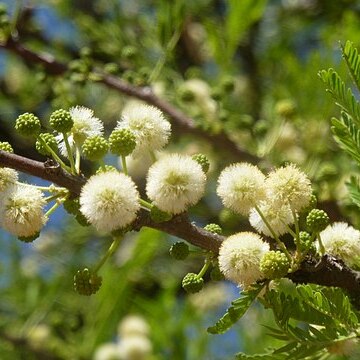Tree to 20 m high, crown irregularly rounded or flattened and spreading, branches usually ascending. Bark grey to dark brown or blackish, usually rough and fissured; young branchlets robust, grey to greyish-or reddish-brown to purplish-black, lenticellate, glabrous to pubescent, smooth, not flaking off to reveal a rusty-red inner layer, eglandular. Stipules spinescent, mostly short and up to 1.2 cm long, sometimes longer, to 7(12.5) cm long, straight or slightly curved, whitish but becoming greyish with age; 'ant-galls' and other prickles absent. Leaves usually borne on distinct 'cushions': petiole (0.3)0.7-2.1 (3.1) cm long, eglandular or with an oval gland up to 1.5 x 1.2 mm a short distance below the lowest pinna pair, glabrous to puberulous;' rhachis (0)2.2-5.1(7.4) cm long, glabrous to pubescent, a small gland at the junction of the top 2 or the lowest pinna pair, sometimes between each pair when few pinnae are present; pinnae (1)3-5(7) pairs; rhachillae (1.2)2-5.6(7.4) cm long, glabrous to pubescent; leaflets (6)10-22(27) pairs per pinna, (2.5)3.5-7.5(17) x 1-3.6(8.5) mm, linear-or obovate-oblong, apex obtuse or rounded, glabrous or occasionally sparingly puberulous beneath, margins glabrous or with conspicuous or inconspicuous cilia. Inflorescences capitate, on axillary peduncles, usually fascicled, seldom solitary. Flowers white, sessile; peduncles 1.2-5.4 cm long, glabrous to shortly pubescent or puberulous, eglandular or inconspicuously glandular; involucel from near the base to just over 1/3-way up the peduncle. Calyx glabrous or apices of lobes sometimes sparingly pubescent, tube 1.2-2.8 mm long, lobes 0.3-0.6 mm long. Corolla glabrous, tube 2.6-3.4 mm long, lobes 0.4-0.8 mm long. Stamen-filaments free, up to 7 mm long; anthers with a deciduous apical gland. Ovary 0.7-1.8 mm long, glabrous, sessile. Pods brown to dark reddish-brown or sometimes blackish, (2.4)6-15(22) x (0.9)1.2-3.1 cm, linear, straight to falcate, apex rounded to acute, longitudinally dehiscent, valves thinly woody, brittle, smooth, ± longitudinally veined, glabrous, attenuate basally. Seeds dark olive-to reddish-brown, 7.5-12 x 5-9 mm, quadrate to subcircular-lenticular, smooth, compressed; areole 5.5-9 x 3.5-6 mm.
More
Shrub or tree, 4.5-8.0(20.0) m high, trunk up to 0.75 m in diam. Bark dark brown to black, rough, deeply fissured. Branches grey to reddish brown when young, glabrous to hairy, smooth. Leaves on distinct woody cushions, bipinnate, rachis 22-51 mm long, pinnae 2-5 pairs, each with 10-15 leaflet pairs. Spines 2, stipular, straight, whitish, 12-60 mm long. Flowers in globular heads, creamy white. Flowering time Aug.-Oct. Pod greyish brown to reddish brown, linear, 60-150 x 12-31 mm, straight to falcate, glabrous, acute, dehiscent.
A tree. It grows 8 m high. It is spiny. It loses its leaves during the year. The pods are straight and wide. There are 3 subspecies.
Can be grown by seedlings. Seeds needs soaking.


